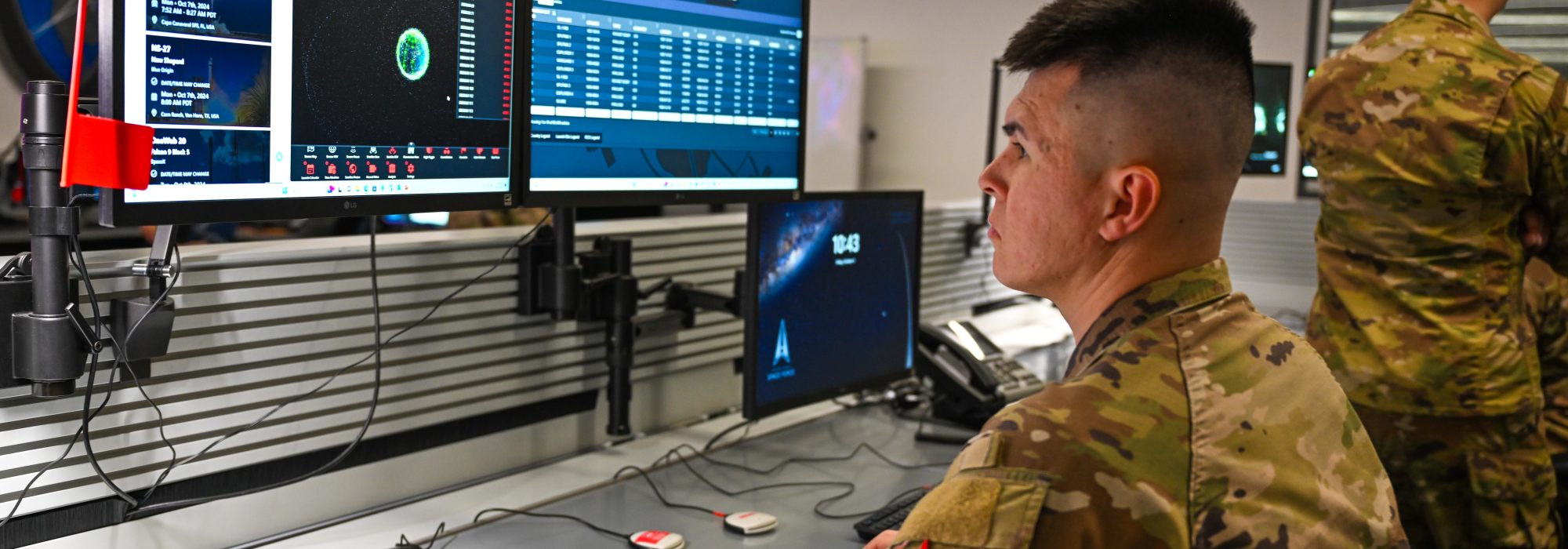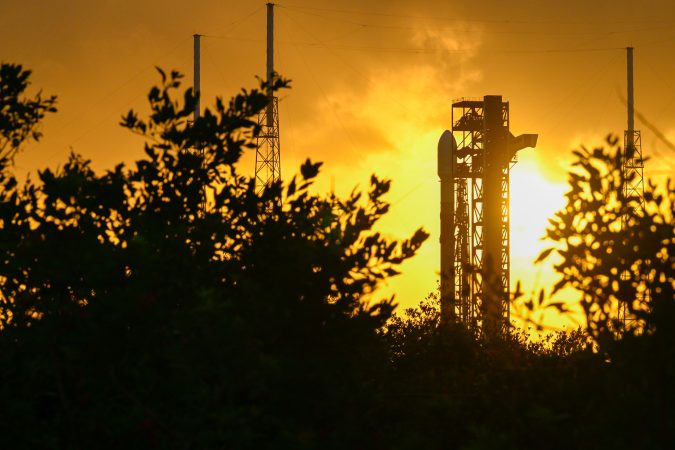Space Force Testing AI Automation
By Greg Hadley
ORLANDO, Fla.
T
he Space Force is flying new command and control software on experimental satellites that automates some functions for ops crews, said Kelly D. Hammett, head of the Space Rapid Capabilities Office.
Dubbed R2C2 for Rapid and Resilient Command and Control, the software is among a wave of new applications that employ artificial intelligence to automate space operations, leaders said here at the Spacepower Conference.
Automation is the No. 1 technology the U.S. needs to gain and maintain space superiority, said Hammett.
“My answer is going to be automation, and automation of the front end of kill chains,” he said in response to a question. “Having early knowledge of local and further-away threats that are tracking, targeting, getting ready to attack you, I think, is one of the key technology areas where we have some significant gaps.”
Hammet said automation is key for speed, and it will require a level of trust that may surprise some people. “We can’t have men in the loop responding to those things, because of the speed and scale at which we’ll have to respond,” he explained. “So we have to be able to automate some of those things and trust that they can respond on their own when they see that they’re going to be destroyed, attacked, threatened, and not have to have Guardians in the loop on that.”
In a subsequent roundtable with reporters, Hammett said his office is investing in R2C2, a program that started in earnest when 20 companies were picked earlier this year to work on it. He said it is already producing capability.
“This fall, we have already established live contacts with flying satellites down at Kirtland Air Force Base, N.M., through the experimental systems that are flying through the [Innovation and Prototyping Acquisition Delta],” Hammett said. “We have migrated R2C2 onto the ops floor there, and the intent is to fly some of the further experimental satellites … and eventually all the flying systems for Delta 9, the orbital warfare delta.”
R2C2 is designed for dynamic space operations, in which satellites must move frequently to dodge threats, gather data, rendezvous to refuel, and more.
Yet as the number of satellites in orbit grows, the risk of collisions also rises—as do potential threats from adversaries. Hammett noted that SpaceX has had to perform thousands of automated maneuvers to protect its Starlink satellites.
R2C2 can help with that, especially as the ratio of satellites to operators keeps rising, challenging Guardians to maintain control.
“The core services of our R2C2 include automated mission planning. You can schedule out a contact or a conjunction maneuver, if you would like to,” Hammett said. “You can plan all that out in an automated sequence. You can run a variety of cases and situations, decide the one you want, and then press the button and it’ll upload a mission profile that says, ‘Go, conduct a series of maneuvers to go conduct a mission’ versus ‘I’m going to talk to you. Turn this on. Turn left, turn right. Go 5 inches, report back to me.’ We’ll automate maneuvers and events.”
The National Reconnaissance Office is also looking at automation. In a separate panel discussion, T.J. Lincoln of the NRO’s Mission Operations Directorate said he has been pushing automation for years.
“Anything I can [automate] in a day of the life of operations, it absolutely is essential,” Lincoln said. “We’ve done that and already gone from, let’s say, 17 folks on a crew to three operating an entire constellation,” he added. “That’s pretty amazing. So automation is absolutely incredibly important today.”
It will only grow more so as the NRO launches dozens of new satellites in a proliferated low-Earth orbit constellation, Lincoln said.
The Space Development Agency is also building a proliferated set of constellations. SDA director Derek M. Tournear said in a speech that autonomous operations will be a key feature in “Tranche 4” of SDA’s Proliferated Space Architecture, scheduled to start launching in 2030.
Other Uses
While Hammett and Tournear look to develop and acquire autonomous ops technology, Space Force commanders today also see the need for artificial intelligence and automation in their work—and some early glimpses of the benefits.
“The simple truth is that in order to operate at the speed we need to, we’re going to need to leverage all of the … machine- learning capability that we can, and then smartly integrate AI tools and applications when they are ready,” said Lt. Gen. David N. Miller, head of Space Operations Command.
Brig. Gen. Anthony J. Mastalir, head of Space Forces Indo-Pacific, said his team is also experimenting with artificial intelligence products and “indirectly” using them in operations.
“We are running a pilot that’s called TacSRT—tactical surveillance, reconnaissance and tracking—and some of the vendors that are contributing to that pilot are working on AI/machine learning applications to better understand what that commercial imagery is showing,” Mastalir said.
Chief of Space Operations Gen. B. Chance Saltzman said one job where AI and automation is critically needed is space domain awareness.
“We get enough data—but we [still] get so much data that our analysts are overwhelmed anyway,” Saltzman said. “The ability for a machine to collect all the data, process the data, and tell the analyst what’s most … high priority, and structure that data in a way that they can make the decision they need—think that’s ripe for software engineering and artificial intelligence.”
The volume of data that needs to be processed and sorted automatically continues to grow—and as it does, operators run the risk of missing something and making a critical mistake, Miller warned.
“The only way to get this done is through automation and fusion,” Miller said. Failing that, “there’s so much data presented that the person who is processing picks their favorite rather than leveraging the suite.” But the Space Force doesn’t want individuals to pick and choose. “We want to leverage all of that and access and open up the enterprise to all of that data,” Miller said, then notify operators automatically when changes in orbit or other concerns arise.
New GPS Satellite
By Greg Hadley
T
he Space Force successfully launched its seventh GPS III satellite into orbit Dec. 16—shaving more than a year and a half off the typical timeline for launching the highest priority national security spacecraft and switching rocket providers to do it.
All told, it took less than five months to pull the satellite from storage, integrate it with the launch vehicle, and go through readiness checks and processing, according to a joint release from the service’s Space Systems Command (SSC) and Space Operations Command (SpOC).
That stands in contrast to the two years it typically takes to prep for a launch as part of the National Security Space Launch program, reserved for the Pentagon and Intelligence Community’s most important missions.
Appropriately, the mission was dubbed RRT-1, for Rapid Response Trailblazer.
The launch, from Cape Canaveral Space Force Station, Fla., was atop a SpaceX Falcon 9 rocket. Back in May 2022, Space Systems Command awarded the launch task order for the GPS III-7 mission to United Launch Alliance, but ULA does not currently have a system certified for NSSL missions—its new Vulcan Centaur rocket is awaiting certification, and its Atlas V rocket had its last launch in July 2024.
As a result, new GPS III satellites that had been declared “ready for launch” were put into storage waiting for a ride to space. In November, SSC Commander Lt. Gen. Philip Garrant hinted that his team was “certainly looking at options to go faster,” specifically by “looking at some of the other GPS missions and the timing of those that have been manifested on SpaceX.”
The command awarded a task order for the next satellite in the series, GPS III-8, to ULA but had not announced plans for the last two editions, GPS III-9 and GPS III-10.
Garrant insisted at the time that the GPS constellation was healthy and the service did not need to rush new satellites into orbit. But on Dec. 17, Lt. Gen. Douglas A. Schiess—commander of Space Forces-Space, the service component to the combatant command—said he was eager to get the new birds up, hailing SSC for completing the process so quickly.
“We have been harping on getting more GPS III satellites on orbit to be able to give us more M-code,” Schiess said at the Center for Strategic and International Studies, referring to the jam-resistant GPS signal for military use.
While other GPS satellites can transmit M-code, the GPS III spacecraft can take advantage of the full capability, including the ability to beam the signal at target areas.
Besides adding more capability to the constellation, the launch also marked another opportunity for the Space Force to speed up its processes for getting satellites into space, as part of an effort called Tactically Responsive Space.
Preparing for a scenario in which it might have to rapidly launch new satellites to replenish constellations after an attack, the Space Force set a record in September 2023 when it launched its “Victus Nox” mission, taking a satellite from the warehouse to orbit in five days. Still more “Victus” missions aimed at going even faster are planned.
But those missions involve smaller payloads and are not part of NSSL, which requires lower risk and higher assurance that the mission will succeed. Meeting that standard for GPS III-7 while slashing months off the timeline required a “twofold” effort from SSC and Space Operations Command, a service release stated, especially after GPS III-7 switched to SpaceX to take advantage of its NSSL-capable rocket.
That the launch still happened so fast despite the turbulence “is a testament to our flexibility and responsiveness,” Col. Jim Horne, senior materiel leader of launch execution for the Assured Access to Space office, said in a statement.
SpOC worked with satellite-maker Lockheed Martin to pull the satellite from storage and finish prelaunch processing in about three months. The launch also marked a milestone for the newly stood-up Mission Delta 31, responsible for position, navigation, and timing, according to commander Col. Andrew Menschner.
“This launch showed our ability to respond quickly to an operational need, such as an on-orbit vehicle failure of the GPS constellation, as well as demonstrating our willingness to challenge traditional timelines associated with launches in response to a realistic scenario,” Menschner said in a statement.
It remains to be seen whether GPS III-8 will stick with Vulcan Centaur as its launch vehicle. ULA hopes for certification soon but has a backlog of government missions. The eighth GPS launch had been set for early 2025.


